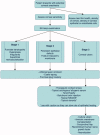Neurotrophic keratopathy: current challenges and future prospects
- PMID: 35243932
- PMCID: PMC8903790
- DOI: 10.1080/07853890.2022.2045035
Neurotrophic keratopathy: current challenges and future prospects
Abstract
Neurotrophic keratopathy (NK), or neurotrophic keratitis, is a degenerative condition that results from decreased innervation to the cornea. The cornea is innervated by the ophthalmic branch of the trigeminal nerve. Neurotrophic keratopathy is most commonly caused by herpes keratitis however, any condition that disrupts the normal corneal innervation can cause NK. Neurotrophic keratopathy is a clinical diagnosis and is classified into three stages based on the disease severity. Stage 1 has mild epithelial defects, such as punctate keratopathy, stage 2 disease has persistent epithelial defects, and stage 3 is defined by the presence of ulcers. Current treatment modalities consist of medical and surgical options. Stage 1 is treated with lubrication through artificial tears, eyelid taping, and punctal plug/cautery. Stage 2 treatment can involve therapeutic contact lenses, topical autologous or allogenic serum, tarsorrhaphy, botulinum toxin injections, and possibly anti-inflammatory medications. Stage 3 disease may require human nerve growth factor, amniotic membrane transplantation, conjunctival flap, or corneal neurotization. New therapies, such as matrix regenerating therapy, plasma rich in growth factors, Thymosin β4, Substance P/Insulin like growth factor-1, and nicergoline represent exciting future options.KEY MESSAGESNeurotrophic keratopathy is a rare degenerative disease defined by decreased innervation to the cornea that is associated with significant morbidity.Treatment options range from lubrication alone to various medical and surgical treatments.Matrix regenerating therapy, plasma rich in growth factors, Thymosin β4, Substance P/Insulin like growth factor-1, and nicergoline are exciting novel therapies that will influence how neurotrophic keratopathy is treated in the future.
Keywords: Mackie classification; Neurotrophic keratitis; autologous serum drops; corneal anaesthesia; corneal nerves; corneal ulcer; neurotization; neurotrophic keratopathy; novel therapies.
Conflict of interest statement
No conflicting relationship exists for any author.
Figures
References
-
- Bonini S, Rama P, Olzi D, et al. . Neurotrophic keratitis. Eye. 2003;17(8):989–995. - PubMed
-
- DelMonte DW, Kim T.. Anatomy and physiology of the cornea. J Cataract Refract Surg. 2011;37(3):588–598. - PubMed
-
- Müller LJ, Marfurt CF, Kruse F, et al. . Corneal nerves: structure, contents and function. Exp Eye Res. 2003;76(5):521–542. - PubMed
-
- Sigelman S, Friedenwald JS.. Mitotic and wound-healing activities of the corneal epithelium; effect of sensory denervation. AMA Arch Ophthalmol. 1954;52(1):46–57. - PubMed
Publication types
MeSH terms
LinkOut - more resources
Full Text Sources
Other Literature Sources

